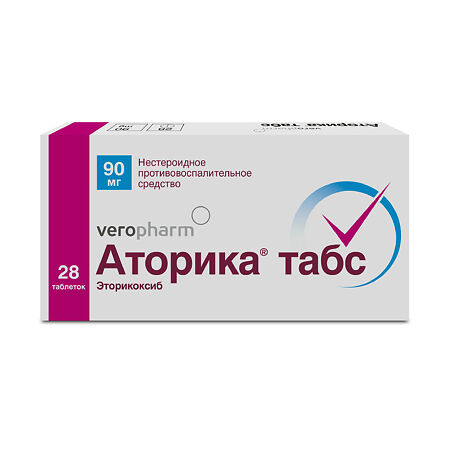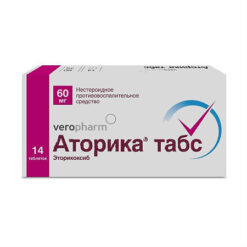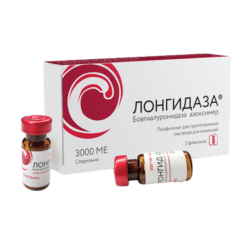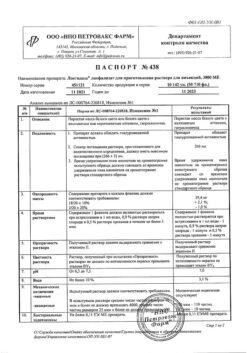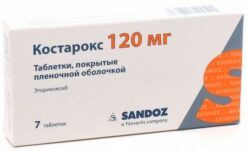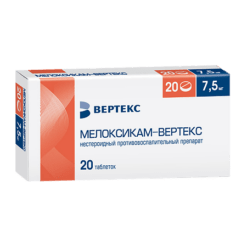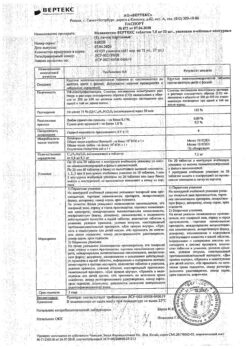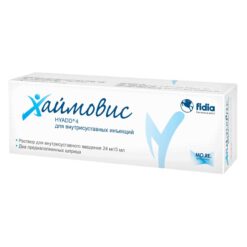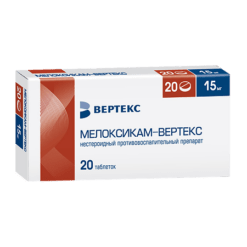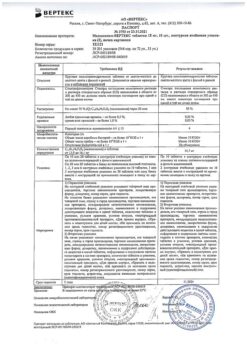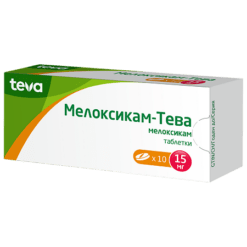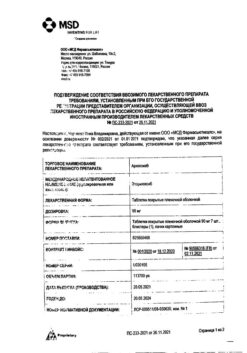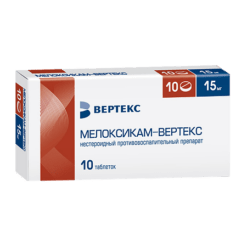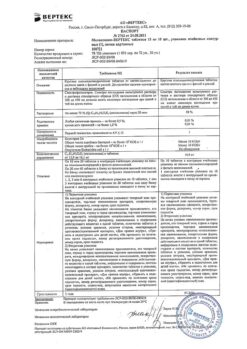No products in the cart.
Atorika, 90 mg 28 pcs.
€22.58 €18.81
Description
Non-steroidal anti-inflammatory drugs (NSAIDs)
ATX code:
M01AN05
Pharmacological properties
Pharmacodynamics
Etoricoxib is a selective cyclooxygenase-2 (COX-2) inhibitor when taken orally in therapeutic concentrations. In clinical pharmacological studies, etoricoxib inhibited COX-2 in a dose-dependent manner, with no effect on COX-1 at a daily dose up to 150 mg. The drug does not inhibit the synthesis of prostaglandins in the gastric mucosa and does not affect platelet function.
Cyclooxygenase is responsible for the formation of prostaglandins. Two isoforms of cyclooxygenase, COX-1 and COX-2, have been isolated. COX-2 is an isoenzyme that is induced by various proinflammatory mediators and is considered the main enzyme responsible for the synthesis of prostanoid mediators of pain, inflammation and fever. COX-2 is involved in the processes of ovulation, implantation and closure of the arterial duct, regulation of the nocicular and central nervous system function (induction of fever, sensation of pain, cognitive function), and may also play a role in the process of ulcer healing. COX-2 has been found in tissues surrounding gastric ulcers in humans, but its importance in ulcer healing has not been established.
Efficacy
In patients with osteoarthritis (OA), etoricoxib, when administered at a dose of 60 mg once daily, provided a significant reduction in pain and improvement in patients’ assessment of their condition. These favorable effects were observed on the second day of treatment and persisted for 52 weeks.
The studies of etoricoxib at a dose of 30 mg once daily (using similar assessment methods) demonstrated efficacy compared to placebo over a treatment period of 12 weeks. In a study conducted to determine the optimal dose, etoricoxib, when used at a dose of 60 mg, demonstrated significantly greater improvement than the 30 mg dose for all three primary endpoints after 6 weeks of treatment. The 30 mg dose has not been studied in hand osteoarthritis.
In patients with rheumatoid arthritis (RA), etoricoxib at a dose of 90 mg once daily provided a significant reduction in pain and inflammation and improved mobility. These favorable effects persisted for a treatment period of 12 weeks.
In patients with acute gouty arthritis, etoricoxib, administered at a dose of 120 mg once daily for an eight-day treatment period, reduced moderate to severe joint pain and inflammation. The efficacy was comparable to that of indomethacin when used in a dose of 50 mg three times a day. Pain reduction was noted as early as four hours after the start of treatment.
In patients with ankylosing spondylitis, etoricoxib at a dose of 90 mg once daily provided a significant reduction in back pain, inflammation, stiffness, and improved function. The clinical efficacy of etoricoxib was observed on the second day of treatment and was sustained for the entire treatment period of 52 weeks.
In a clinical study of pain after dental surgery, etoricoxib at a dose of 90 mg was administered once daily for three days.
In a subgroup of patients with moderate pain (at baseline assessment), etoricoxib had the same analgesic effect as ibuprofen at a dose of 600 mg when administered at 90 mg (16.11 vs. 16.39 P=0.722), and was superior to the paracetamol/codeine combination at a dose of 600 mg/60 mg (11.00, P< 0.001) and placebo (6.84, P< 0.001), according to the overall assessment of pain reduction during the first 6 hours (TOPAR6). The proportion of patients who required rapid-acting pain medication within the first 24 hours of taking the study drugs was 40.8% with etoricoxib at 90 mg, 25.5% with ibuprofen at 600 mg every 6 hours, and 46.7% with the paracetamol/codein combination at 600 mg/60 mg every 6 hours, compared with 76.2% in the placebo group. In this study, the median onset of action (perceived pain reduction) with etoricoxib at a dose of 90 mg was 28 minutes after administration.
Safety
The MEDAL (Multinational Assessment of Long-Term Prescribing of Etoricoxib and Diclofenac in Arthritis) Program
The MEDAL Program. The MEDAL program was a prospective safety assessment program based on cardiovascular (CV) events from pooled data from three randomized, double-blind, active-controlled trials: MEDAL, EDGE II and EDGE.
The MEDAL study was a trial, the duration of which was determined by the achievement of endpoints (CC events), that included 17,804 patients with OA and 5,700 patients with RA receiving etoricoxib at a dose of 60 mg (OA) or 90 mg (OA and RA) or diclofenac at a dose of 150 mg daily for an average of 20.3 months (maximum 42.3 months, median 21.3 months). Only serious adverse events and dropouts due to any adverse events were reported in this study.
The EDGE and EDGE II studies compared the gastrointestinal tolerability of etoricoxib and diclofenac. The EDGE study included 7111 patients with OA who received etoricoxib at a dose of 90 mg per day (1.5 times the recommended dose for OA) or diclofenac at a dose of 150 mg per day for an average of 9.1 months (maximum 16.6 months, median 11.4 months). The EDGE II study included 4,086 patients with RA who received etoricoxib at a dose of 90 mg daily or diclofenac at a dose of 150 mg daily for an average of 19.2 months (maximum 33.1 months, median 24 months).
In the combined MEDAL Program, 34,701 patients with OA or RA were treated for an average of 17.9 months (maximum 42.3 months, median 16.3 months); about 1,800 patients were treated for more than 24 months. Patients included in the MEDAL Program had a wide range of CV and gastrointestinal risk factors at baseline assessment. Patients with recent myocardial infarction and with aortocoronary bypass or percutaneous coronary intervention within 6 months before study inclusion were excluded. Gastroprotectants and low-dose aspirin were allowed in the studies.
Cardiovascular Safety Results
The incidence of confirmed serious thrombotic SS adverse events (which included cardiac, cerebrovascular, and peripheral vascular events) was comparable between the groups receiving etoricoxib or diclofenac (data are shown in Table 1 below).
There were no statistically significant differences in the incidence of thrombotic events between etoricoxib and diclofenac in all subgroups analyzed, including patient categories in the baseline CC risk range. The relative risk for confirmed serious thrombotic CC adverse events was similar for etoricoxib (when administered at 60 mg or 90 mg) and diclofenac (when administered at 150 mg).
Table 1. Frequency of confirmed thrombotic CC events (MEDAL Program)
| Etoricoxib (N=16819) 25836 patient-years | Diclofenac (N=16483) 24766 patient-years | Comparison between treatment types | |||
| Frequency1 (95% CI) | Frequency1 (95% CI) | Relative risk (95% CI) | |||
| Confirmed thrombotic CC serious adverse events | |||||
| When protocol requirements are met | 1.24(1.11; 1.38) | 1.30(1.17; 1.45) | 0.95(0.81; 1.11) | ||
| Depending on treatment prescribed | 1.25(1.14; 1.36) | 1.19(1.08; 1.30) | 1.05 (0.93; 1.19) | ||
| Confirmed cardiac events | |||||
| When protocol requirements are met | 0.71 (0.61; 0.82) | 0.78 (0.68; 0.90) | 0.90 (0.74; 1.10) | ||
| Depending on treatment prescribed | 0.69 (0.61; 0.78) | 0.70 (0.62; 0.79) | 0.99 (0.84; 1.17) | ||
| Confirmed cerebrovascular events | |||||
| When protocol requirements are met | 0.34 (0.28; 0.42) | 0.32 (0.25; 0.40) | 1.08 (0.80; 1.46) | ||
| Depending on the treatment prescribed | 0.33 (0.28; 0.39) | 0.29 (0.24; 0.35) | 1.12 (0.87; 1.44) | ||
| Confirmed peripheral vascular events | |||||
| When protocol requirements are met | 0.20(0.15; 0.27) | 0.22(0.17; 0.29) | 0.92(0.63; 1.35) | ||
| Depending prescribed treatment | 0.24 (0.20; 0.30) | 0.23 (0.18; 0.28) | 1.08 (0.81; 1.44) | ||
1 Number of events per 100 patient-years; CI=confidence interval; N=total number of patients included in the patient population who met protocol requirements.
When protocol requirements are met, all events that developed on study therapy within 14 days of discontinuation (excludes patients who received <75% of study drug and patients who took non-included NSAIDs >10% of the time).
Depending on the assigned treatment – all confirmed phenomena that developed before the end of the study (patients who may have undergone non-included interventions after discontinuation of the study drug are included). Total number of randomized patients: n=17412 for etoricoxib and n=17289 for diclofenac.
The CC mortality and overall mortality were comparable between the etoricoxib and diclofenac treatment groups.
Cardiorenal events
Approximately 50% of patients included in the MEDAL study had a history of arterial hypertension at baseline assessment. The dropout rate due to adverse events related to arterial hypertension was statistically significantly higher for etoricoxib than for diclofenac.
The frequency of adverse events associated with chronic heart failure (dropouts and serious events) was similar for etoricoxib at 60 mg and diclofenac at 150 mg, but was higher for etoricoxib at 90 mg compared to diclofenac at 150 mg (and statistically significantly higher for etoricoxib at 90 mg compared to diclofenac at 150 mg in the MEDAL trial OA group).
The incidence of confirmed adverse events associated with chronic heart failure (events that were serious and resulted in hospitalization or emergency department visits) was marginally higher for etoricoxib compared to diclofenac at the 150 mg dose; this effect was dose-dependent. Study dropout rates due to edema-related adverse events were higher for etoricoxib compared with diclofenac at a dose of 150 mg; this effect was dose-dependent (statistically significant for etoricoxib at a dose of 90 mg, but not for etoricoxib at a dose of 60 mg).
The results of the EDGE and EDGE II studies are consistent with the results in the MEDAL study. In individual MEDAL studies, the absolute dropout rate in any treatment group for etoricoxib (60 mg or 90 mg) was up to 2.6 percent for arterial hypertension, up to 1.9 percent for edema, and up to 1.1 percent for chronic heart failure. Patients taking etoricoxib at a dose of 90 mg had a higher dropout rate than patients taking etoricoxib at a dose of 60 mg.
The results of the MEDAL gastrointestinal tolerability assessment
In each of the three MEDAL studies, the dropout rate for any clinical GI adverse event (e.g., dyspepsia, abdominal pain, ulcers) was significantly lower for etoricoxib compared to diclofenac. The dropout rate due to GI adverse clinical events per 100 patient-years for the entire study period was as follows: 3.23 for etoricoxib and 4.96 for diclofenac in the MEDAL study; 9.12 for etoricoxib and 12.28 for diclofenac in the EDGE study; and 3.71 for etoricoxib and 4.81 for diclofenac in the EDGE II study.
The MEDAL Gastrointestinal Safety Assessment Results
In general, upper GI adverse events were defined as perforations, ulcers, and bleeding. Complicated upper GI adverse events included perforations, obstruction and complicated bleeding; uncomplicated upper GI adverse events included uncomplicated bleeding and uncomplicated ulcers. The overall incidence of upper gastrointestinal adverse events was significantly lower for etoricoxib compared with diclofenac.
There were no significant differences between etoricoxib and diclofenac for the incidence of complicated events. For upper gastrointestinal hemorrhagic adverse events (complicated and uncomplicated combined), no significant differences were found between etoricoxib and diclofenac. The advantage of etoricoxib in the upper gastrointestinal tract compared to diclofenac in patients simultaneously taking low-dose aspirin (about 33% of patients) was not statistically significant.
The incidence of confirmed complicated and uncomplicated upper GI clinical adverse events per 100 patient-years (perforations, ulcers, and bleeding) was 0.67 (95% CI 0.57; 0.77) for etoricoxib and 0.97 (95% CI 0.85; 1.10) for diclofenac, based on which the relative risk was 0.69 (95% CI 0.57; 0.83).
The incidence of confirmed upper GI adverse events in elderly patients was examined; the maximum reduction was observed in patients aged ≥75 years, 1.35 (95% CI 0.94; 1.87) compared to 2.78 (95% CI 2.14; 3.56) events per 100 patient-years for etoricoxib and diclofenac, respectively. The incidence of confirmed lower GI adverse events (small or large bowel perforation, obstruction, or bleeding) did not differ significantly between the etoricoxib and diclofenac groups.
The MEDAL liver safety results
Etoricoxib had a statistically significantly lower dropout rate due to liver adverse events compared to diclofenac. In the combined MEDAL Program, 0.3% of patients receiving etoricoxib and 2.7% of patients receiving diclofenac dropped out of the study due to liver adverse events. The incidence of adverse events per 100 patient-years was 0.22 for etoricoxib and 1.84 for diclofenac (p< 0.001 for etoricoxib versus diclofenac). Most liver adverse events in the MEDAL Program were not serious.
Additional safety data related to thrombotic CC events
In clinical trials other than the MEDAL Program trials, approximately 3,100 patients received etoricoxib at a dose of ≥60 mg daily for 12 weeks or longer. There were no notable differences in the incidence of confirmed serious thrombotic CC events in patients receiving etoricoxib ≥60 mg, placebo, or naproxen-free NSAIDs. However, compared with patients receiving naproxen at a dose of 500 mg twice daily, the incidence of these events was higher in patients receiving etoricoxib.
The difference in antiplatelet activity between some COX-1 inhibiting NSAIDs and COX-2 selective inhibitors may be of clinical significance in patients at risk for thromboembolic events. Selective COX-2 inhibitors inhibit systemic (and possibly endothelial) prostacyclin formation without affecting platelet thromboxane. The clinical significance of these observations has not been established.
Additional Gastrointestinal Safety Data
. In two double-blind, 12-week endoscopic studies, the cumulative incidence of gastroduodenal ulcers was significantly lower in patients receiving etoricoxib at a dose of 120 mg once daily than in patients receiving naproxen at a dose of 500 mg twice daily or ibuprofen at a dose of 800 mg three times daily. The incidence of ulcers was higher with etoricoxib compared to placebo.
The study of renal function in elderly patients
. A randomized, double-blind, placebo-controlled, parallel-group study evaluated the effects of 15 days of therapy with etoricoxib (90 mg), celecoxib (200 mg twice daily), naproxen (500 mg twice daily) and placebo on renal sodium excretion, blood pressure (BP) and other measures of renal function in patients aged 60 to 85 years who received a sodium diet of 200 mEq/day. Etoricoxib, celecoxib, and naproxen had similar effects on sodium excretion by the kidneys after 2 weeks of treatment.
All active comparison drugs resulted in an increase in systolic BP relative to placebo, but etoricoxib therapy resulted in a statistically significant increase in systolic BP at day 14 compared with celecoxib and naproxen (mean change for systolic BP compared with baseline: etoricoxib – 7.7 mm Hg, celecoxib, 2.4 mmHg; naproxen, 3.6 mmHg).
Pharmacokinetics
Absorption
Etoricoxib is rapidly absorbed when taken orally. Absolute bioavailability when administered orally is about 100%. When the drug is used in adults on an empty stomach in a dose of 120 mg once a day until reaching equilibrium state the maximum concentration (Cmax) is 3.6 mcg/ml. Time of reaching maximum concentration (TCmax) in blood plasma is 1 h after drug administration. Geometric mean AUC0-24h is 37.8 µg*h/ml. Pharmacokinetics of etoricoxib within therapeutic doses is linear.
There was no clinically significant effect on the absorption rate when etoricoxib was taken at a dose of 120 mg with meals (high-fat meals). The rate of absorption was altered, resulting in a 36% decrease in Cmax and an increase in TCmax by 2 h.
These results are not considered clinically significant. In clinical studies, etoricoxib was used independently from food intake.
Distribution
Etoricoxib is approximately 92% bound to human plasma proteins at concentrations of 0.05-5 µg/mL. The volume of distribution (Vdss) in the equilibrium state is about 120 liters.
Etoricoxib penetrates the placental barrier and the blood-brain barrier.
Metabolism
Etoricoxib is extensively metabolized. Less than 1% of etoricoxib is excreted unchanged by the kidneys. The main route of metabolism is the formation of 6′-hydroxymethylethoricoxib, catalyzed by enzymes of the cytochrome system. CYP3A4 contributes to the metabolism of etoricoxib in vivo. In vitro studies indicate the CYP2D6, CYP2C9, CYP1A2 and CYP2C19 isoenzymes can also catalyze the major metabolic pathway, but their quantitative effects in vivo have not been studied.
In humans, 5 metabolites of etoricoxib have been identified. The main metabolite is 6′-carboxyacetylacetoricoxib, which is formed by additional oxidation of 6′-hydroxymethylacetoricoxib. These major metabolites have no appreciable activity or are weak COX-2 inhibitors. None of these metabolites inhibits COX-1.
On single intravenous administration of labeled radioactive etoricoxib to healthy volunteers at a dose of 25 mg, 70% of etoricoxib was excreted through the kidneys, 20% – through the intestine, mostly as metabolites. Less than 2% was found unchanged.
Excretion of etoricoxib is mainly by metabolism with subsequent excretion through the kidneys.
The equilibrium concentration is reached when 120 mg of etoricoxib is taken daily after 7 days with a cumulation coefficient of about 2, which corresponds to a half-life of about 22 hours. Plasma clearance after intravenous administration of 25 mg is approximately 50 ml/min.
Pecial patient groups
Elderly patients
The pharmacokinetics in elderly patients (65 years and older) are comparable to those in younger patients.
Performance
The pharmacokinetics of etoricoxib are similar in men and women.
Hepatic impairment
In patients with mild hepatic impairment (Child-Pugh score 5-6) the dosage of etoricoxib 60 mg once daily was associated with increase in AUC by 16% compared to healthy subjects who received the drug in the same dose.
In patients with moderate hepatic dysfunction (Child-Pugh score 7-9) taking etoricoxib 60 mg once daily, the average AUC was the same as in healthy subjects taking etoricoxib daily in the same dose. Etoricoxib at a dose of 30 mg once daily has not been studied in this population. Clinical and pharmacokinetic studies in patients with severe hepatic impairment (>10 Child-Pugh score) are not available.
Renal failure
The pharmacokinetic parameters of a single dose of etoricoxib 120 mg in patients with moderate to severe renal impairment and with end-stage chronic renal failure (CKF) under hemodialysis were not significantly different from those in healthy subjects. Hemodialysis had little effect on excretion (dialysis clearance was about 50 ml/min).
Children
Pharmacokinetic parameters of etoricoxib in children under 12 years old have not been studied.
. In a pharmacokinetic study (n=16) conducted in adolescents aged 12 to 17 years, the pharmacokinetics in adolescents weighing 40 to 60 kg when taking etoricoxib at a dose of 60 mg once daily and in those weighing more than 60 kg when taking etoricoxib at a dose of 90 mg once daily were similar to the pharmacokinetics in adults when taking etoricoxib at a dose of 90 mg once daily. The safety and efficacy of etoricoxib in children has not been established.
Indications
Indications
Active ingredient
Active ingredient
Composition
Composition
How to take, the dosage
How to take, the dosage
Interaction
Interaction
Pharmacodynamic Interactions
Peroral Anticoagulants (Warfarin)
In patients receiving warfarin, an etoricoxib dose of 120 mg daily was associated with an increase of approximately 13% in the international normalized ratio (INR) prothrombin time. In patients receiving oral anticoagulants, prothrombin time and INR should be monitored at the start of treatment or when treatment with etoricoxib is changed, particularly in the first few days.
Diuretics, angiotensin-converting enzyme (ACE) inhibitors and angiotensin II receptor antagonists
NSAIDs may impair the effect of diuretics and other antihypertensive drugs. In some patients with impaired renal function (e.g., patients with dehydration or elderly patients with impaired renal function), simultaneous use of an ACE inhibitor or angiotensin II receptor antagonist and cyclooxygenase inhibitor drugs may lead to additional impairment of renal function, including possible development of acute renal failure, which is usually reversible.
Patients taking etoricoxib concomitantly with ACE inhibitors or angiotensin II receptor antagonists should be aware of the possibility of these interactions. Such a combination should be administered with caution, especially in elderly patients. At the beginning of combined treatment, as well as at certain intervals thereafter, fluid replacement should be performed and renal function monitoring should be considered.
Acetylsalicylic acid
In a study involving healthy volunteers, etoricoxib at a dose of 120 mg daily at equilibrium had no effect on the antiplatelet activity of acetylsalicylic acid (81 mg once daily). Etoricoxib can be used concomitantly with acetylsalicylic acid in low doses intended for prevention of CC diseases.
Special Instructions
Special Instructions
Gastrointestinal effects
There have been cases of upper gastrointestinal complications (perforations, ulcers or bleeding), sometimes with fatal outcome, in patients who received etoricoxib. It is recommended to exercise caution when treating patients with a high risk of GI complications when using NSAIDs, particularly in elderly patients who simultaneously use other NSAIDs, including acetylsalicylic acid, as well as in patients with a history of GI diseases such as ulcers or gastrointestinal bleeding.
There is an additional risk of adverse gastrointestinal reactions (gastrointestinal ulcers or other gastrointestinal complications) when etoricoxib and acetylsalicylic acid are used simultaneously (even at low doses). In long-term clinical trials, there were no significant differences in GI safety with selective COX-2 inhibitors in combination with acetylsalicylic acid compared to the use of NSAIDs in combination with acetylsalicylic acid.
Indications on the cardiovascular system
The results of clinical studies suggest that the use of drugs of the class of selective COX-2 inhibitors is associated with an increased risk of thrombotic events (especially myocardial infarction and stroke) relative to placebo and some NSAIDs. Since the risk of SS disease with selective COX-2 inhibitors may increase with increasing dose and duration of use, it is necessary to choose the shortest possible duration of use and the lowest effective daily dose. The patient’s need for symptom management and response to therapy should be periodically evaluated, especially for patients with osteoarthritis.
Patients with known risk factors for CC complications (such as arterial hypertension, hyperlipidemia, diabetes mellitus, smoking) should only be prescribed etoricoxib after careful assessment of benefit and risk.
The selective COX-2 inhibitors are not a substitute for acetylsalicylic acid in the prevention of SS because they have no effect on platelets. Therefore, the use of antiplatelet agents should not be discontinued.
Impact on renal function
Renal prostaglandins may play a compensatory role in maintaining renal perfusion. In the presence of conditions that adversely affect renal perfusion, administration of etoricoxib may cause decreased formation of prostaglandins and decreased renal blood flow and thus reduce renal function. The greatest risk of this reaction is in patients with a significant decrease in renal function, uncompensated heart failure, or a history of cirrhosis. In such patients, renal function should be monitored.
Fluid retention, edema and arterial hypertension
As with other prostaglandin synthesis inhibiting drugs, fluid retention, edema and arterial hypertension have been observed in patients using etoricoxib. All NSAIDs, including etoricoxib, may be associated with the occurrence or recurrence of chronic heart failure.
Caution should be exercised when prescribing etoricoxib in patients with a history of heart failure, left ventricular dysfunction, or arterial hypertension, as well as in patients with pre-existing edema from any other cause. If there are clinical signs of deterioration in such patients, appropriate measures should be taken, including discontinuation of etoricoxib.
The use of etoricoxib, especially in high doses, may be associated with more frequent and severe arterial hypertension than with some other NSAIDs and COX-2 selective inhibitors. During treatment with etoricoxib, special attention should be paid to BP control, which should be monitored for 2 weeks after the start of treatment and periodically thereafter.
An alternative treatment should be considered if there is a significant increase in BP.
Synopsis
Synopsis
Contraindications
Contraindications
Caution should be exercised when using the drug in the following patient groups:
Side effects
Side effects
The safety of etoricoxib was evaluated in clinical studies involving 7152 participants, including 4614 patients with OA, RA, chronic low back pain and ankylosing spondylitis (approximately 600 patients with OA or RA were treated for one year or longer).
In clinical trials, the adverse effect profile was similar in patients with OA or RA who received etoricoxib for one year or longer.
In a clinical trial of acute gouty arthritis, patients received etoricoxib at a dose of 120 mg/day for 8 days. The adverse effect profile in this study was generally the same as in the pooled studies of OA, RA and chronic low back pain.
In the SS Safety Assessment Program, which included data from three active-controlled studies, 17412 patients with OA or RA received etoricoxib at a dose of 60 mg or 90 mg for an average of 18 months.
In clinical trials of acute postoperative pain associated with dental surgery, in which 614 patients received etoricoxib at a dose of 90 mg or 120 mg, the adverse effect profile was generally similar to that in the pooled studies of OA, RA and chronic low back pain.
. The following adverse reactions were reported with greater frequency with the drug than with placebo in clinical trials involving patients with OA, RA, chronic low back pain or ankylosing spondylitis who were taking etoricoxib at a dose of 30 mg, 60 mg, or 90 mg with increases in the recommended dose over 12 weeks, in MEDAL studies lasting up to 3.5 years, in short-term acute pain studies, and in postmarketing use (Table 2).
Table 2. Summary of adverse reactions
1 According to the frequency reported in the clinical trial database: Very common (â¥1/10), common (â¥1/100 to < 1/10), infrequent (â¥1/1000 to < 1/100), rare (â¥1/10000 to < 1/1000), very rare (< 1/10000).
2 This adverse reaction has been reported during post-marketing surveillance. The frequency of reports was estimated based on the highest frequency observed in clinical trials pooled according to dose and indication.
3 The frequency category “Rare” was determined according to the guidelines (version 2, September 2009) for the Brief Drug Characterization based on the estimated upper limit of the 95% confidence interval for 0 events, given the number of patients who received etoricoxib in the phase III data analysis pooled according to dose and indication (n=15470).
4 Hypersensitivity includes the terms “allergy,” “drug allergy,” “drug hypersensitivity,” “hypersensitivity unspecified,” “hypersensitivity reaction,” and “non-specific allergy.
5 According to data from an analysis of long-term placebo-controlled and actively controlled clinical trials, the use of selective COX-2 inhibitors increases the risk of serious arterial thrombotic events, including myocardial infarction and stroke. Based on available data, it is unlikely that the absolute risk of these events exceeds 1% per year (infrequent).
The following serious adverse events have been reported in association with NSAID use and cannot be excluded for etoricoxib: nephrotoxicity, including interstitial nephritis and nephrotic syndrome.
Overdose
Overdose
Pregnancy use
Pregnancy use
Similarities
Similarities
Additional information
| Weight | 0.080 kg |
|---|---|
| Shelf life | 2 years. Do not use after the expiration date. |
| Conditions of storage | At a temperature not exceeding 25 ° C in the secondary packaging (cardboard box). Keep out of reach of children. |
| Manufacturer | Kanonfarma Production ZAO, Russia |
| Medication form | pills |
| Brand | Kanonfarma Production ZAO |
Other forms…
Related products
Buy Atorika, 90 mg 28 pcs. with delivery to USA, UK, Europe and over 120 other countries.

